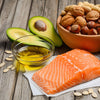Is Fat a Better Fuel than Carbs or Protein? Ketones vs. Sugars!

 Food as Fuel
Food as Fuel
While plants may be able to turn air, water, and sunshine into fuel, the animal kingdom must use one of three macronutrients for fuel: carbohydrates, proteins or fats. The energy provided by one gram of either carbohydrate or protein is approximately 4 calories, compared to 9 calories from a gram of fat. Ignoring the biochemistry of the human metabolic machine, the concept of balancing caloric requirements based on activity has dominated the American approach to weight loss or maintenance for the last century. Concerns regarding cardiovascular health as well as weight loss goals have guided food manufacturers to introduce low-fat foods for decades as the go-to “healthy” meal or snack choice. These foods are typically high in carbohydrate and lower in protein and promote caloric surplus in the diet. Another more recent food trend has been the addition of fiber to everything from cereal to water, but again the focus is on carbohydrates. The 21st century has seen products with added protein in acknowledgment of dietary trends to lower carbohydrate intake and promote satiety. But what role does dietary fat truly play as an energy source? This article seeks to address two basic questions: How do these three macronutrients compare as fuel sources? How might these fuels lead to health or disease?
A Disconnect Between Health and Healthy Eating
Low-fat diets have been at the center of dietary guidelines in the United States for several decades, yet obesity [1] and type 2 diabetes [2] rates are rising. From 1999 to 2010, an 8.7% increase in adherence to U.S. dietary guidelines [1] occurred at the same time as a 5.2% increase in obesity among adults. [3] In 1962, 46% of adults in the United States were considered overweight or obese; as of 2010, this percentage has risen to 75%. [3, 4] A fear of fat has been instilled in the minds of most Americans, as many people look to fat-free foods in hopes of losing weight or simply to maintain health. The problem with this approach is that when the fat is taken out of foods, sugar and salt are usually added to improve flavor, and caloric intake is typically greater. When coupled with regular consumption of sugary beverages and snacks, a high-carb, low-fat diet may be promoting the prevalence of obesity and type 2 diabetes in the population.
USDA Dietary Guidelines
A notable shift in the American dietary guidelines has been the move away from the food pyramid. 1992 saw the introduction of the food pyramid and it remained the symbol of nutrition until 2005 when an updated MyPyramid was rolled out. In 2011, the USDA installed MyPlate as the new model for healthy eating. Fats and added sugar were removed from the charts beginning in 2005. The most recent 2015 – 2020 Dietary Guidelines for Americans set forth by the U.S. Department of Health and Human Services and U.S. Department of Agriculture advises against consumption of added sugar, i.e. “consume less than 10 percent of calories per day from added sugars.” [3] The recommendations also suggest limiting saturated fats, i.e. “consume less than 10 percent of calories per day from saturated fats.” [3] Saturated fats are found in meats and dairy products including cheeses and butter. Overall, the guidelines encourage consumption of various high-carbohydrate foods (vegetables, fruits, grains) as well as lean protein. [5] The reduction in added sugar is likely a step in the right direction to mitigate caloric surplus and hunger, as well as address the nation’s sugar addiction. More work needs to be done, however, to make the population aware that fat can be both healthy and beneficial when consumed in ways discussed in this article.

Carbohydrates – Glycolysis-Driven Metabolism
Consumption of foods and beverages high in carbohydrates leads to the production of glucose as the main fuel source (sugar). [6] When the body metabolizes carbohydrates, a rise in blood glucose occurs, stimulating the pancreas to produce insulin (a growth promoting hormone) in order to regulate blood sugar levels. [6] Insulin not only lowers blood glucose by facilitating glucose transport in muscle and fat tissue, but it also stimulates the synthesis of glycogen, fat, and protein. [6] Any glucose that is not immediately used for energy is stored as glycogen in the liver and muscle, which can be broken back down to glucose and used for energy at a later time. [7]
Since only a finite amount of glycogen storage is available, any excess glucose is stored as fat. As blood sugar levels decrease, the pancreas produces another hormone, glucagon, which prompts the liver to release more glucose in an attempt to maintain homeostasis (steady state levels of glucose). [6] Ultimately, high levels of glucose and insulin can both promote fat storage. [6] Constant fluctuations in blood sugar commonly observed in people consuming high-carbohydrate diets may lead to medical problems such as obesity, metabolic syndrome, and diabetes. Medical problems linked to high-carbohydrate diets and elevated blood sugar/ insulin include, but are not limited to: insulin resistance [8], obesity [9], type 2 diabetes [10], heart disease [10], hypertension [10], cancer [11], and polycystic ovary syndrome (PCOS). [12, 13, 14]
Proteins
Consumption of protein (either animal or plant based) leads to the release of amino acids for the building blocks of muscle and a host of other proteins within the body. There is no “storage depot” for protein in the body, so any excess consumption beyond what the body needs for building muscle is simply wasted. However, when fuel levels are low (blood sugar or blood ketones are low), protein can also be converted to either glucose or ketones, which are then used as fuels. Some amino acids are glucogenic (are used to make glucose, which may raise blood sugar in certain individuals), others are ketogenic (used to make ketones, as better described below). While there are individual reports of high-protein meals raising blood sugar or “kicking” one out of ketosis, there remains a need to conduct controlled studies to understand the effects of protein on blood glucose and ketone levels.
Fats – Ketone-Driven Metabolism, an Alternative Fuel Source
Consumption of dietary fat generates fatty acids that can immediately be used by most tissues for energy (the exception is the brain which can only use glucose or ketones for energy). Excess dietary fats are stored as triglycerides (with unlimited storage potential). Under conditions of low carbohydrate intake (low blood glucose), triglycerides can be converted in the liver to ketone bodies. Ketones are produced by the liver through beta-oxidation of fatty acids that can come from fats in our diet, as well as our own fat stores, and by a process referred to as hepatic ketogenesis. [15] The ketones referred to herein are actually biologically ketone bodies and include the molecules beta-hydroxybutyrate (BHB), acetoacetate (AcAc) and acetone (Ac). These ketone bodies should not be confused with raspberry ketones, an ingredient found in raspberries that is marketed as a weight loss supplement, though its efficacy in humans remains unknown. [16] Ketone bodies and raspberry ketones are completely different, both chemically and physiologically.
Ketosis – A Metabolic Switch
Ketosis is a normal physiological state that simply indicates that blood ketone levels are higher than normal. For example, under a typical American diet with high carbohydrate intake, blood ketone levels are usually at or below 0.5 mMol. Under these conditions, glucose provides the vast majority of fuel for the body. During ketosis, however, ketones not only provide the majority of the body’s fuel, but may also offer numerous health benefits resulting from steady-state glucose and insulin levels, as well as increased satiety. [17, 18, 19, 20]
During fasting or when consuming a high-fat, moderate protein, low-carbohydrate diet, the body generates ketones, derived from fat, for its energy source [15], leading to stabilization of blood glucose levels, and improved insulin sensitivity. [10, 18] The body is able to maintain normal blood glucose levels despite minimal to no carbohydrate consumption. The liver uses gluconeogenesis to produce blood glucose from molecules that are not carbohydrates such as lactate, pyruvate, glycerol, and some amino acids. [7] Essentially, the body does not need much dietary carbohydrate to obtain energy during a state of ketosis [15]. Fats and ketones act as the body’s food/energy source in this state. [15] During ketosis, once the body has utilized available dietary fats for energy, it will begin breaking down fat stores to achieve its energy requirements, triggering weight loss in the process. [21]
Ketoacidosis is NOT Equivalent to Nutritional Ketosis
Diabetic ketoacidosis (DKA) is a dangerous medical condition observed primarily in type 1 diabetics and some type 2 diabetics. During DKA, ketone and (usually) glucose levels are extremely high, accompanied by a lack of insulin and low blood pH. [15]. During DKA, blood ketone levels (BHB: see methods of measuring ketones) can range from 3 to above 20 millimolar (mM) and blood pH decreases (< 7.3 and downwards to < 7.0). [22] Blood glucose levels above 250-300 mg/dl or approximately 14 mM are also typically seen. [15] In contrast, fasting ketosis can lead to levels of up to 8 mM ketones, < 100mg/dl glucose and have no significant impact on blood pH. Nutritional ketosis leads to ketones ranging from 0.5 to 3 mM, with mild fluctuations in blood glucose and no effects on blood pH. [23]
Methods of Measuring Ketones
Ketone levels can be measured with blood meters, breath testing, or urine strips. Note that the liver produces three main ketone bodies: beta-hydroxybutyrate (BHB), acetoacetate (AcAc) and acetone (Ac). [15] Blood ketone meters measure BHB, the primary ketone body found in the blood [24]. Breath meters measure acetone [25], the ketone body produced by the breakdown of AcAc, and have been shown to correlate closely to BHB levels [26]. Urine strips, on the other hand, measure acetoacetate [24], and are much less reliable for measuring ketosis, especially when the body becomes adapted to using ketones as the primary energy substrate (usually occurs after a few weeks of being in nutritional ketosis). [23] Since the urine strips solely measure ketone excretion, the body excretes fewer ketones via urine once keto-adapted.
Methods to Achieve Ketosis
There are several approaches to achieving the metabolic switch to ketosis:
- Fasting Ketosis
Though difficult, fasting leads to ketosis. [15] This is an evolutionary advantage considering the lack of a constant food supply prior to the agricultural revolution. As glycogen stores deplete, the body begins to break down fat stores to obtain energy. Short-term fasting (1-3 days) is an effective way to achieve ketosis. Medical supervision is recommended.
- Nutritional Ketosis Through Dietary Carbohydrate Restriction
Classic Ketogenic Diet – The most common, well-known method to achieve nutritional ketosis is via the ketogenic diet, in which the ratio of dietary fat to nonfat (carbohydrates and protein) is 3:1 – 4:1 (gram:gram). This concept has been tried in medical centers such as Johns Hopkins for over a century to treat drug-resistant epilepsy in children. [23] The induction phase of the popular Atkins Diet also starts with a very high-fat ratio. Less restrictive ketogenic diets can have 3:1 or even 2:1 ratios, once the metabolic shift to ketosis is made. Typically, carbohydrate levels start at 10-15 grams per day, and then slowly go up over the course of several days to weeks to determine an individual’s carbohydrate tolerance. Some individuals (such as athletes) may be able to achieve nutritional ketosis while consuming up to 100 grams of carbohydrates per day, though many need to stay below 50 grams of carbohydrates to remain in ketosis. [23] Liberal fat consumption typically provides enough energy.
Modified Atkins Diet – This diet is thought to be a more liberal version of the classic ketogenic diet, as it allows for more protein to be consumed. The ratio of fat to protein plus carbohydrates for this diet is 1:1 – 2:1.
Low Glycemic Index Diet – This diet may or may not induce ketosis, depending upon the blood glucose levels of the individual and the fat content of the diet. In this approach, carbohydrate-based foods (fruits, vegetables, grains) are selected based on their ability to raise blood glucose.
Protein and Ketosis – During nutritional ketosis, in addition to carbohydrate restriction and high fat intake, it is essential to moderate protein, as excess protein can be converted to glucose [27], and thus attenuate or prevent ketosis from occurring. Significant anecdotal evidence suggests that the consumption of too much protein on a low-carbohydrate diet can prevent or reverse ketosis. High quality saturated and monounsaturated fats are typically recommended while avoiding trans/hydrogenated fats. [28]
- Exogenous Ketone Supplementation
Ketogenic foods that can help increase fat intake and/or ketone production include coconut oil, medium chain triglycerides (MCT oil), and butter. Additionally, ketone supplements are currently being tested, developed, and marketed. Many of these products have the potential to assist with the metabolic shift to nutritional ketosis. Using these products in conjunction with a standard high-carbohydrate diet to achieve ketosis in humans is the subject of many ongoing research studies. It has been shown in rats that oral exogenous ketone supplementation can induce nutritional ketosis without dietary restriction. [29]
Potential Side Effects
During ketosis, the kidneys excrete sodium and water more efficiently [23], leading to increased thirst and urination. Adequate hydration and electrolyte replacement are central to most ketogenic diets (particularly sodium, potassium, and magnesium). [23] Without sufficient amounts of these vital nutrients, the “keto flu” is a very common side effect, and can be characterized by headaches, fainting, and fatigue, as the body switches from glucose to ketones as an energy source. [23] The paper linked below addresses some contraindications associated with the ketogenic diet.
http://onlinelibrary.wiley.com/doi/10.1111/j.1528-1167.2008.01765.x/epdf
Research Update: Ketosis and Medical Conditions
Current academic research into the potential medical use of ketogenic diets and ketone supplementation is examining several areas of disease including neuroprotection [30], type 2 diabetes [18, 23, 31], metabolic syndrome [23], and cancer. [32, 33, 34, 35, 36]
Conclusion
Each individual has different metabolic and nutritional needs, so it is impossible to establish a “one size fits all” type diet or protocol to follow to achieve nutritional ketosis. One can measure ketone and blood glucose levels while evaluating physical outcomes such as weight loss, fatigue, focus, sleep, and energy. It is advisable to work with a physician or dietitian knowledgeable in ketogenic diets and ketosis. This article should not be taken as medical advice, but rather as valuable information and insight for those interested in low-carbohydrate living and ketosis. Always consult a doctor, especially if you have a pre-existing medical condition.
References
1. Ogden, C.L., et al., Prevalence of obesity among adults and youth: The United States, 2011–2014.
2. Control, C.f.D., and Prevention, National Diabetes statistics report: estimates of diabetes and its burden in the United States, 2014. Atlanta, GA: US Department of Health and Human Services, 2014.
3. Flegal, K.M., et al., Prevalence of obesity and trends in the distribution of body mass index among US adults, 1999-2010.JAMA, 2012. 307(5): p. 491-497.
4. Fryar, C.D., M.D. Carroll, and C.L. Ogden, Prevalence of overweight, obesity, and extreme obesity among adults: The United States, trends 1960–1962 through 2009–2010. Hyattsville, MD: National Center for Health Statistics, 2012.
5. Agriculture, U.S.D.o.H.a.H.S.a.U.S.D.o., 2015–2020 Dietary Guidelines for Americans. 2015. 8th Edition.
6. Aronoff, S.L., et al., Glucose Metabolism and Regulation: Beyond Insulin and Glucagon. Diabetes Spectrum, 2004. 17(3): p. 183-190.
7. McKee, T. and J.R. McKee, Biochemistry: the molecular basis of life. 2016.
8. Wolever, T.M., Dietary carbohydrates and insulin action in humans. Br J Nutr, 2000. 83 Suppl 1: p. S97-102.
9. Ginsberg, H.N., Insulin resistance and cardiovascular disease. The Journal of Clinical Investigation, 2000. 106(4): p. 453-458.
10. Daly, M.E., et al., Dietary carbohydrates and insulin sensitivity: a review of the evidence and clinical implications. The American Journal of Clinical Nutrition, 1997. 66(5): p. 1072-85.
11. Key, T.J. and E.A. Spencer, Carbohydrates and cancer: an overview of the epidemiological evidence. Eur J Clin Nutr, 0000. 61(S1): p. S112-S121.
12. Burghen, G., J. Givens, and A. Kitabachi, Correlation of hyperandrogenism with hyperinsulinism in polycystic ovarian disease.J Clin Endocrinol Metab, 1980. 50.
13. Dunaif, A., Insulin resistance and the polycystic ovary syndrome: mechanism and implications for pathogenesis. Endocr Rev, 1997. 18.
14. Legro, R.S., et al., Prevalence and predictors of risk for type 2 diabetes mellitus and impaired glucose tolerance in polycystic ovary syndrome: a prospective, controlled study in 254 affected women. J Clin Endocrinol Metab, 1999. 84.
15. Laffel, L., Ketone bodies: a review of physiology, pathophysiology, and application of monitoring to diabetes. Diabetes Metab Res Rev, 1999. 15(6): p. 412-26.
16. Lopez, H.L., et al., Eight weeks of supplementation with a multi-ingredient weight loss product enhances body composition, reduces hip and waist girth, and increases energy levels in overweight men and women. Journal of the International Society of Sports Nutrition, 2013. 10(1): p. 22.
17. Dashti, H.M., et al., Long-term effects of a ketogenic diet in obese patients. Experimental & Clinical Cardiology, 2004. 9(3): p. 200-205.
18. Boden, G., et al., Effect of a low-carbohydrate diet on appetite, blood glucose levels, and insulin resistance in obese patients with type 2 diabetes. Ann Intern Med, 2005. 142.
19. Yancy, W., et al., A low-carbohydrate, ketogenic diet to treat type 2 diabetes. Nutr Metab, 2005. 2.
20. Nielsen, J. and E. Joensson, Low-carbohydrate diet in type 2 diabetes: stable improvement of bodyweight and glycemic control during 44 months follow-up. Nutr Metab, 2008. 5.
21. Manninen, A.H., Metabolic Effects of the Very-Low-Carbohydrate Diets: Misunderstood “Villains” of Human Metabolism.Journal of the International Society of Sports Nutrition, 2004. 1(2): p. 7-11.
22. Sheikh-Ali, M., et al., Can Serum β-Hydroxybutyrate Be Used to Diagnose Diabetic Ketoacidosis? Diabetes Care, 2008. 31(4): p. 643-647.
23. Cervenka, M.C., et al., Worldwide dietary therapies for adults with epilepsy and other disorders. J Child Neurol, 2013. 28(8): p. 1034-40.
24. van Delft, R., et al., Blood beta-hydroxybutyrate correlates better with seizure reduction due to ketogenic diet than do ketones in the urine. Seizure, 2010. 19(1): p. 36-39.
25. Musa-Veloso, K., et al., Breath acetone predicts plasma ketone bodies in children with epilepsy on a ketogenic diet. Nutrition, 2006. 22(1): p. 1-8.
26. Tom, P.J.B., et al., Comparison of breath gases, including acetone, with blood glucose and blood ketones in children and adolescents with type 1 diabetes. Journal of Breath Research, 2014. 8(4): p. 046010.
27. Paoli, A., et al., Beyond weight loss: a review of the therapeutic uses of very-low-carbohydrate (ketogenic) diets. Eur J Clin Nutr, 2013. 67.
28. Kummerow, F.A., The negative effects of hydrogenated trans fats and what to do about them. Atherosclerosis, 2009. 205(2): p. 458-465.
29. Kesl, S.L., et al., Effects of exogenous ketone supplementation on blood ketone, glucose, triglyceride, and lipoprotein levels in Sprague–Dawley rats. Nutrition & Metabolism, 2016. 13(1): p. 9.
30. Smith, S.L., D.J. Heal, and K.F. Martin, KTX 0101: a potential metabolic approach to cytoprotection in major surgery and neurological disorders. CNS Drug Rev, 2005. 11(2): p. 113-40.
31. McKenzie, L.A., et al., A Novel Intervention Including Individualized Nutritional Recommendations Reduces Hemoglobin A1c Level, Medication Use, and Weight in Type 2 Diabetes. JMIR Diabetes, 2017. 2(1): p. e5.
32. Allen, B.G., et al., Ketogenic diets as an adjuvant cancer therapy: History and potential mechanism. Redox Biology, 2014. 2: p. 963-970.
33. Poff, A.M., et al., Non-Toxic Metabolic Management of Metastatic Cancer in VM Mice: Novel Combination of Ketogenic Diet, Ketone Supplementation, and Hyperbaric Oxygen Therapy. PLoS One, 2015. 10(6): p. e0127407.
34. Seyfried, T.N., et al., Metabolic Control of Brain Cancer: Role of Glucose and Ketone Bodies. Proc Amer Assoc Cancer Res, 2005. 46.
35. Abdelwahab, M.G., et al., The ketogenic diet is an effective adjuvant to radiation therapy for the treatment of malignant glioma. PLoS One, 2012. 7(5): p. e36197.
36. Klement, R.J. and C.E. Champ, Calories, carbohydrates, and cancer therapy with radiation: exploiting the five R’s through dietary manipulation. Cancer metastasis reviews, 2014. 33(1): p. 217-229.




